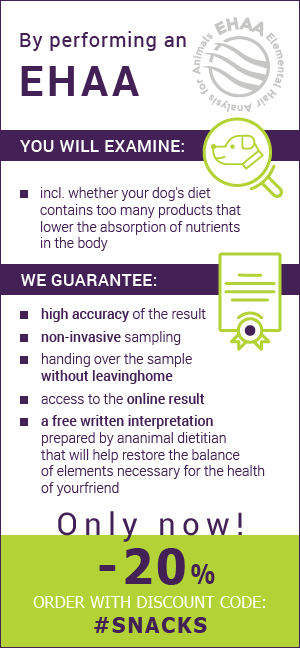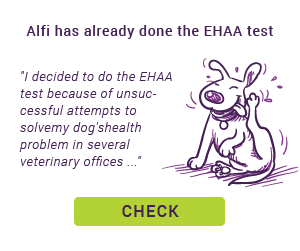The humanisation of animals has become a significant problem. People often feed their pets while preparing meals, and sometimes their four-legged friends even join them at the dining table. Pet owners forget that dogs are a different species and have different needs, including different food requirements. Many products that are found in most kitchens are hazardous to the health and sometimes even life of pets.
CHOCOLATE, COCOA
Most pantries have chocolate and cocoa, particularly during Christmas, Valentine’s Day and Easter. For humans, this isn’t just a tasty snack, but also a source of magnesium, potassium, phosphorus and iron. For dogs, chocolate is poisonous, and so they need different sources of these elements. It contains theobromine – methylxanthine, which the body excretes very slowly. Both one-off consumption of a large amount of chocolate and frequent consumption of small amounts are dangerous. The deadly dose of theobromine is 250‑500 mg/kg of body weight. The largest concentration of this substance is found in dark chocolate and cocoa. The theobromine content in selected products is presented in table 1.
Symptoms of poisoning: heart rhythm disturbances, breathing difficulties, anxiety, vomiting (often with blood), diarrhoea, seizures.
In some cases, there can be kidney damage, coma, or even death. If you suspect that your dog has eaten chocolate, take it to the vet immediately.
Table 1 Theobromine content in selected products
| PRODUCT |
THEOBROMINE CONTENT
(mg/g product) |
| powdered cocoa |
4,5-30 |
| dark chocolate |
12-19,6 |
| milk chocolate |
1,5-2 |
| white chocolate |
0,009-0,035 |
XYLITOL
Xylitol is a natural sweetener obtained from the bark of birch. It contains 40% less calories than regular sugar (sucrose) and has a lower glycaemic index. This is why it’s recommended for people on a diet and diabetics. Xylitol is very quickly absorbed by the canine circulatory system and stimulates the pancreas to secrete insulin, which is a hormone that lowers blood glucose levels. Xylitol consumption in amounts over 0.1g/kg of body weight in dogs can lead to hypoglycaemia, which is life threatening. In addition, liver damage can occur. This sweetener is found in many products, e.g. chewing gum, biscuits, lollies, mouth wash, and toothpaste. You should pay close attention to labels, because it often appears as “birch sugar” or “E967”.
Symptoms of poisoning: vomiting, weakness, ataxia (impaired motor coordination), collapse, coma.
GRAPES AND SULTANAS
It’s not only fresh grapes that can be dangerous to dogs, but also dried one – sultanas. We still don’t know which substance they contain is poisonous. In some dogs, eating even a few hundred grams of this fruit causes no symptoms, while other dogs can die after consuming only several grams. The lowest toxic dose is 2.8 g of sultanas and 19.6 g of grapes/kg of body weight. Poisoning can lead to acute renal failure.
Symptoms of poisoning: vomiting (often with pieces of grapes/sultanas), apathy, diarrhoea, loss of appetite, decreased urine output or anuria.
AVOCADO
Avocado is a rich source of potassium, which is an element that regulates blood pressure. Unfortunately, it shouldn’t be fed to dogs, because it’s toxic to them. Interestingly, it’s not the fruit itself that’s dangerous, but the fungicide used in its cultivation – persin. It’s found in both the fruit and leaves of avocados. It causes difficulty in eliminating water from the body, which can result in pulmonary oedema, as well as circulatory failure due to fluid build-up around the heart.
Symptoms of poisoning: gastrointestinal irritation, diarrhoea, vomiting, breathing difficulties.
CITRUS
Citrus fruits are another snack that you should avoid giving dogs. They contain psoralen and essential oils that irritate the mucous membranes. Citrus consumed in larger amounts can lead to gastrointestinal disorders.
Symptoms of poisoning: irritation of the nasal mucosa and eyes, vomiting, diarrhoea, apathy.
FRUIT STONES
The stones of fruit such as apples, peaches, apricots and cherries pose a danger to dogs for two reasons. Firstly, if swallowed whole, they can lead to intestinal obstruction. Secondly, they contain a compound from which hydrocyanide is formed. Poisoning occurs as a result of swallowing damaged stones, or if your dog chews them.
Symptoms of poisoning: excessive salivation, vomiting, breathing difficulties, seizures, collapse, an almond-like smell of exhaled air.
ONION, GARLIC, CHIVES, LEEK
Alliums, including onion, garlic, chives and leek, are toxic to dogs because they contain disulfides. They damage erythrocytes and cause haemoglobin denaturation. In this way, they lead to impaired oxygen transport by the blood. Heat doesn’t neutralise the toxins in these plants – they’re dangerous in raw, cooked and dried forms. The toxic dose is 5-10 g/kg of body weight for onion and 5 g/kg of body weight (for seven consecutive days) for garlic.
Symptoms of poisoning: haemolytic anaemia, vomiting and diarrhoea, pallor of the mucous membranes, apathy, dyspnoea.
SORREL, RHUBARB, SPINACH
Sorrel, rhubarb and spinach have high amounts of oxalic acid. This acid contributes to a deterioration of the use of minerals from food. Its harmful effects mainly consist of binding calcium and magnesium. Excessive consumption of products containing oxalic acid may lead to the precipitation of calcium oxalate stones and, consequently, the development of nephrolithiasis and renal failure.
POTATOES
Cooked potatoes pose no danger to dogs. However, raw potatoes – particularly green ones that are sprouting – are a problem. The green skin and young shoots of potatoes contain toxic solanine. It irritates the gastrointestinal mucosa and causes inflammation.
Symptoms of poisoning: excessive salivation, vomiting, diarrhoea.
MACADAMIA NUTS
Macadamia nuts aren’t very popular in Poland. But they are found in biscuits and other sweets. The toxic substance in these nuts is cyanogenic glycosides. Clinical symptoms of poisoning appear after the consumption of just 0.7 g of nuts/kg of body weight. However, they usually resolve spontaneously after two days.
Symptoms of poisoning: vomiting, fever, movement disorders, seizures.
MUSHROOMS
Mushrooms are difficult to digest for both humans and dogs. Species that are widely considered as edible can cause indigestion and diarrhoea in dogs. In addition, dogs used to the taste of mushrooms may try to eat them on walks. There’s a risk that they may come across a poisonous species.
Symptoms of poisoning: excessive salivation, seizures, stomach pain, vomiting.
ALCOHOL
Alcohol poisoning can occur not only after the consumption of alcoholic beverages but also fermenting apples or raw yeast-based dough. During leavening, dough undergoes a fermentation process that produces ethanol (alcohol). After ethanol is consumed, it is very quickly absorbed by the body and causes symptoms of poisoning. The toxic dose is an individual matter – each time alcohol is consumed it’s risky.
Symptoms of poisoning: behavioural changes, movement disorders, weakening of reflexes, excitement or depression, breathing difficulties, fainting, cardiac arrest.
MILK AND MILK PRODUCTS
Milk and milk products contain lactose – milk sugar, which is broken down in the small intestine by lactase. Lactase is an enzyme whose activity starts to gradually decline at approximately six to eight weeks of life. As a result, the body loses the ability to effectively digest lactose, and the consumption of milk or milk products leads to indigestion, diarrhoea and bloating. It’s also worth remembering that milk products contain high amounts of fat, and an excess can contribute to overweight and obesity. That’s why it’s recommended that you don’t include dairy in your dog’s diet.
HEAT-TREATED BONES
Bones are very controversial food in dog diets. Their use is justified only in the case of dogs fed on the BARF diet or other evolutionary diets. What’s more, these bones must be raw and include a decent layer of meat. It’s only then that there’s no danger to dogs. Bones that have been subjected to heat (cooked, fried, smoked) change their structure – they become hard and brittle. Their sharp fragments can lead to perforation of the oesophagus, stomach or intestines. The same risk exists in the case of bones without meat. The next danger is that the intestines become obstructed by faecal matter mixed with bone mass. This applies not only to dogs on the BARF diet (poorly balanced ration), but also to four-legged friends fed commercial dog food that has received a “treat” from their owner in the form of bones, for example, bones left over after dinner. It’s also worth mentioning bones available in pet stores. Despite salespeople recommending them, they’re not suitable for any type of dog. These bones are “naked” and often heat treated. When buying such a bone for your pet, you risk tooth damage, perforation of the digestive tract, and obstruction of the intestines.
COFFEE AND TEA
Both coffee and tea contain caffeine. This is a substance that intensifies the toxic effects of theobromine and can lead to poisoning. The toxic dose of caffeine is 150 mg/kg of body weight in dogs. The first symptoms of poisoning appear one to two hours after consumption. The caffeine content in selected products is presented in table 2.
Symptoms of poisoning: anxiety, hyperactivity, vomiting, increased heart rate, increased respiratory rate, fever, heart rhythm disturbances.
Tabela 2. Zawartość kofeiny w wybranych produktach
| PRODUCT |
CAFFEINE CONTENT (mg) |
| one cup of roasted coffee (150 ml) |
85 |
| one cup of instant coffee (150 ml) |
60 |
| one cup of decaffeinated coffee (150 ml) |
3 |
| one cup of brewed tea (150 ml) |
30 |
| one cup of instant tea (150 ml) |
20 |
| one cup of cocoa (150 ml) |
4 |
SALT
An excess of salt in meals can lead to dysregulation of the body’s water management, metabolic disorders, as well as renal failure. Dogs are often fed cold cuts, sausages, frankfurters and cheese. Owners forget (or are unaware) that these contribute to not only excess calories, but also high amounts of salt.
Symptoms of poisoning: increased thirst, excessive salivation, increased urination, kidney failure.
SUMMARY
When feeding your dog, don’t forget that it’s a different species and has different needs to humans. Sometimes things that are good for you can prove dangerous for your four-legged friend. It’s worth remembering which products are poisonous for dogs and to avoid them in your dog’s diet. If you really want to share a snack with your dog, you can give it a piece of cooked or dried meat (without salt or spices), fruit (e.g. apples (without seeds), raspberries, bananas or strawberries) or vegetables (cooked sweet potato, carrot or parsley root).
inż. zootechnik, Katarzyna Żmuda
1.Ceregrzyn M., Barszczewska B., Lechowski R. 2019. Podstawy żywienia psów i kotów. Wydawnictwo Edra Urban & Partner. Wrocław
2.Cholewiak-Górlaczyk A. 2020. Nie dla psa (i kota) kiełbasa, czyli jak zdrowo karmić swojego zwierzaka. Wydawnictwo Otwarte. Kraków
3.Cortinovis C., Caloni F. 2016. Household Food Items Toxic to Dogs and Cats. Frontiers in Veterinary Science, nr 3
4.Jank M., Wilczak J. 2011. Jak żywić psa. Zdrowa dieta, smakołyki, przygotowanie karmy. Multico Oficyna Wydawnicza. Warszawa
5.Kovalkovičová N., Šutiaková I., Pistl J., Šutiak V. 2009. Some food toxic for pets. Interdisciplinary Toxicology, nr 2(3), s. 169-176
6.Mirowski A. 2013. Warzywa i owoce w żywieniu psów i kotów. Część II. Życie Weterynaryjne, nr 88(3), s. 207-209
7.Sapierzyński R., Wojtczak M., Filich M. 2018. Zatrucie winogronami i rodzynkami u psów. Życie Weterynaryjne, nr 93(6), s. 411-413















